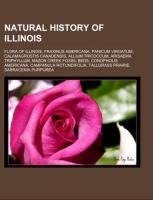
Natural history of Illinois
Source: Wikipedia. Pages: 40. Chapters: Flora of Illinois, Fraxinus americana, Panicum virgatum, Calamagrostis canadensis, Allium tricoccum, Arisaema triphyllum, Mazon Creek fossil beds, Conopholis americana, Campanula rotundifolia, Tallgrass prairie, Sarracenia... Viac o knihe
Produkt je dočasne nedostupný
14.52 €
bežná cena: 16.50 €
O knihe
Source: Wikipedia. Pages: 40. Chapters: Flora of Illinois, Fraxinus americana, Panicum virgatum, Calamagrostis canadensis, Allium tricoccum, Arisaema triphyllum, Mazon Creek fossil beds, Conopholis americana, Campanula rotundifolia, Tallgrass prairie, Sarracenia purpurea, Ceanothus americanus, Viburnum opulus, Arctostaphylos uva-ursi, Rhus typhina, Osmundastrum cinnamomeum, Symplocarpus foetidus, Cypripedium reginae, Hydrangea arborescens, Cornus sericea, Boltonia decurrens, Asclepias meadii, Asarum canadense, Allium canadense, Oenothera speciosa, Eurybia macrophylla, Lindera benzoin, Trillium sessile, Ambrosia artemisiifolia, Lobelia inflata, Dalea foliosa, Vitis palmata, Vaccinium angustifolium, Carex pensylvanica, Maianthemum canadense, Symphyotrichum novae-angliae, Ambrosia trifida, Schizachyrium scoparium, Opuntia humifusa, Andropogon gerardii, Northern highbush blueberry, Platanthera leucophaea, Vallisneria americana, Smilax rotundifolia, Ribes missouriense, Canadian blueberry, Virginia Bluebell, Hydrocotyle ranunculoides, Calopogon tuberosus, Phlox divaricata, Utricularia cornuta, Viburnum acerifolium, Iris cristata, Phoradendron leucarpum, Galearis spectabilis, Cypripedium pubescens, Campanula americana, Aplectrum, Gentiana crinita, Dodecatheon meadia, Scrophularia marilandica, Polygonatum biflorum, Carex scoparia, Thismia americana, Iva annua, Bromus kalmii, Huperzia porophila, Athyrium asplenioides, Stygobromus lucifugus, Blowout grass. Excerpt: Panicum virgatum, commonly known as switchgrass, is a perennial warm season bunchgrass native to North America, where it occurs naturally from 55°N latitude in Canada southwards into the United States and Mexico. Switchgrass is one of the dominant species of the central North American tallgrass prairie and can be found in remnant prairies, in native grass pastures, and naturalized along roadsides. It is used primarily for soil conservation, forage production, game cover, as an ornamental grass, and more recently as a biomass crop for ethanol and butanol, in phytoremediation projects, fiber, electricity, and heat production and for biosequestration of atmospheric carbon dioxide. Other common names for switchgrass include tall panic grass, Wobsqua grass, blackbent, tall prairiegrass, wild redtop, thatchgrass, and Virginia switchgrass. Root system of switchgrass grown at the Land InstituteSwitchgrass is a hardy, deep-rooted, perennial rhizomatous grass that begins growth in late spring. It can grow up to 2.7 m high, but is typically shorter than big bluestem grass or indiangrass. The leaves are 30-90 cm long, with a prominent midrib. Switchgrass uses C4 carbon fixation, giving it an advantage in conditions of drought and high temperature. Its flowers have a well-developed panicle, often up to 60 cm long, and it bears a good crop of seeds. The seeds are 3-6 mm long and up to 1.5 mm wide, and are developed from a single-flowered spikelet. Both glumes are present and well developed. When ripe, the seeds sometimes take on a pink or dull-purple tinge, and turn golden brown with the foliage of the plant in the fall. Switchgrass is both a perennial and self-seeding crop, which means farmers do not have to plant and reseed after annual harvesting. Once established, a switchgrass stand can survive for ten years or longer. Unlike corn, switchgrass can grow on marginal lands and requires relatively modest levels of chemical fertilizers. Overall, it is considered a resource-effici
- Vydavateľstvo: Books LLC, Reference Series
- Formát: Paperback
- Jazyk:
- ISBN: 9781157888420


 Anglický jazyk
Anglický jazyk 
 Nemecký jazyk
Nemecký jazyk 







